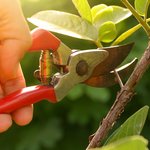

As fall turns to winter, you may be looking at the bare, brown branches in your yard and wondering when to cut them back. Overall, the answer is not yet! But there’s lots to think about before pruning season starts. Read on for advice on timing and techniques for pruning trees and shrubs.
The best time to prune most plants is in the late dormant season – generally around January or February. It’s ideal to prune while temperatures are below freezing to reduce the risk of disease, and waiting until late winter ensures that new growth will quickly seal the cuts in the spring. The exception to this rule is that trees and shrubs that bloom early in the growing season on last year’s growth should be pruned immediately after they finish blooming. These include azalea, flowering cherry, forsythia, lilac, and magnolia. There are also some specific best practices for pruning hydrangeas, which I’ll talk about below.
Pruning is both an art and a science, and it can be intimidating to start cutting your prized trees and shrubs. For large mature trees, it’s often best to call a professional who has the experience and equipment to do the job right (and safely). But for shrubs and smaller trees, don’t worry too much – as long as you don’t remove more than about a third of a shrub (or 20% of a tree), you probably won’t hurt the plant.
First, remove any diseased, broken, or dead branches, and any branches that are growing directly downward or upward. Whenever two branches are crossed, tangled, or rubbing together, remove one of the branches at its base. Next, remove any small branches growing too low on a tree’s trunk (often referred to as “suckers”). It’s recommended to remove entire branches whenever possible, to thin out your tree or shrub. If you only cut off part of a branch, it can encourage more growth below the cut, which can create an odd shape. However, if you do prune a branch in the middle, you should cut above a bud facing the outside of the plant, to encourage the new branch to grow in that direction. Finally, when pruning trees, make sure not to cut the “leader,” or the vertical stem at the top of the trunk. This can weaken the tree and destroy its natural shape.
Now, as promised, let’s talk about hydrangeas. Hydrangeas are very popular in Minnesota, and widely loved for their long-lasting, showy blooms. But best practices for pruning hydrangeas are different depending on the specific type you’re growing, causing confusion for many home gardeners.
There are four main types of hydrangeas grown in Minnesota: panicle, bigleaf, smooth, and climbing. Panicle hydrangeas have cone-shaped flower clusters, which provide nice winter interest in the garden. They regrow on previous seasons’ growth, so it’s best to prune back dead branches and spent flowers in late winter or spring. Bigleaf hydrangeas have the classic round flower clusters, and they form flower buds in late summer for the following season. Therefore, you should aim to prune them in summer right after the flowers fade, to avoid removing next year’s blooms. However (to make things even more confusing), Endless Summer is a popular variety of bigleaf hydrangea, but it produces blooms on both old and new wood, so it will bloom nicely whether you prune it or not. Smooth hydrangeas can be identified from their green, flexible, and relatively soft stems. They grow on new wood each year, so you can prune them down to the ground around March. Finally, climbing hydrangeas form a tough, gnarly vine and rarely or never need pruning, except to remove dead wood.
One last tip: I recommend putting pruning on your calendar for sometime in January or February so you don’t forget! You may not be thinking about gardening with snow on the ground, and it’s easy to accidentally let the ideal pruning window pass. But a bit of advance planning will ensure that your trees and shrubs are healthy and beautiful in the coming year.
For more information, check out the University of Minnesota Extension Yard and Garden website. Extension resources are written by experts, and contain the latest and most reliable research-based information. Happy gardening!
Comments
No comments on this item Please log in to comment by clicking here